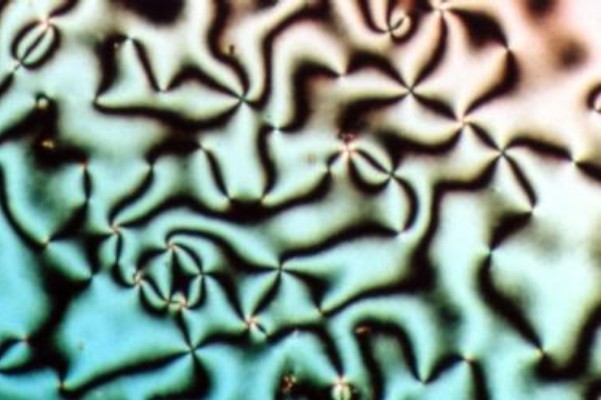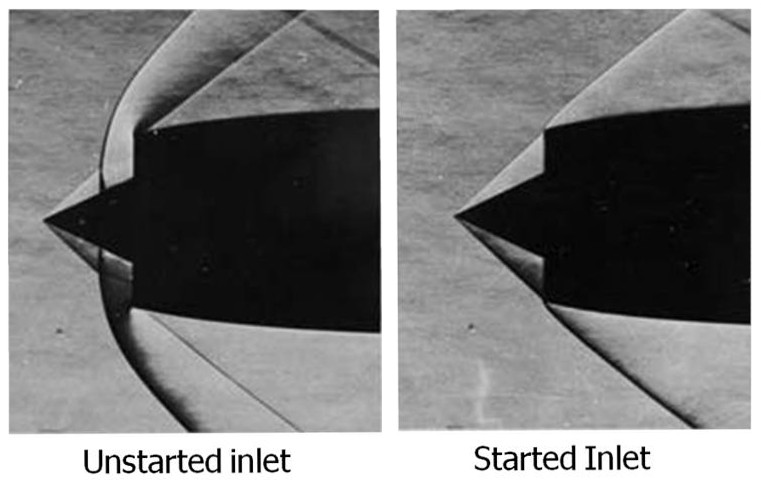|
Biaxial Nematic
A biaxial nematic is a spatially homogeneous liquid crystal with three distinct optical axes. This is to be contrasted to a simple nematic, which has a single preferred axis, around which the system is rotationally symmetric. The symmetry group of a biaxial nematic is D_ i.e. that of a rectangular right parallelepiped, having 3 orthogonal C_2 axes and three orthogonal mirror planes. In a frame co-aligned with optical axes the second rank order parameter tensor, the so-called Q tensor of a biaxial nematic has the form : \mathbf Q= \begin -\frac(S+P) & 0 &0 \\ 0 &-\frac(S-P) & 0 \\ 0 & 0& S\\ \end where S is the standard Liquid_crystal#Order_parameter, nematic scalar order parameter and P is a measure of the biaxiality. The first report of a thermotropic biaxial nematic appeared in 2004 based on a boomerang shaped oxadiazole bent-core mesogen. The biaxial nematic phase for this particular compound only occurs at temperatures around 200 °C and is preceded by as yet unidentified ... [...More Info...] [...Related Items...] OR: [Wikipedia] [Google] [Baidu] |
Liquid Crystal
Liquid crystal (LC) is a state of matter whose properties are between those of conventional liquids and those of solid crystals. For example, a liquid crystal can flow like a liquid, but its molecules may be oriented in a common direction as in a solid. There are many types of LC Phase (matter), phases, which can be distinguished by their Optics, optical properties (such as Texture (crystalline), textures). The contrasting textures arise due to molecules within one area of material ("domain") being oriented in the same direction but different areas having different orientations. An LC material may not always be in an LC state of matter (just as water may be ice or water vapour). Liquid crystals can be divided into three main types: thermotropic, lyotropic, and #Metallotropic liquid crystals, metallotropic. Thermotropic and lyotropic liquid crystals consist mostly of organic molecules, although a few minerals are also known. Thermotropic LCs exhibit a phase transition into the L ... [...More Info...] [...Related Items...] OR: [Wikipedia] [Google] [Baidu] |
Schlieren Texture
Schlieren ( ; , ) are optical inhomogeneities in transparent media that are not necessarily visible to the human eye. Schlieren physics developed out of the need to produce high-quality lenses devoid of such inhomogeneities. These inhomogeneities are localized differences in optical path length that cause deviations of light rays, especially by refraction. This light deviation can produce localized brightening, darkening, or even color changes in an image, depending on the directions the rays deviate. History Schlieren were first observed by Robert HookeHooke, R. (1665), "Of a New Property in the Air", ''Micrographia'', Observation LVIII, pp. 217–219, London. in 1665 using a large concave lens and two candles. One candle served as a light source. The warm air rising from the second candle provided the schliere. The conventional schlieren system is credited mostly to German physicist August Toepler, though Jean Bernard Léon Foucault invented the method in 1859 that Toe ... [...More Info...] [...Related Items...] OR: [Wikipedia] [Google] [Baidu] |
Phases Of Matter
In the outline of physical science, physical sciences, a phase is a region of material that is chemically uniform, physically distinct, and (often) mechanically separable. In a system consisting of ice and water in a glass jar, the ice cubes are one phase, the water is a second phase, and the humid air is a third phase over the ice and water. The glass of the jar is a different material, in its own separate phase. (See .) More precisely, a phase is a region of space (a thermodynamic system), throughout which all physical properties of a material are essentially uniform. Examples of physical properties include density, refractive index, index of refraction, magnetization and chemical composition. The term ''phase'' is sometimes used as a synonym for state of matter, but there can be several Miscibility, immiscible phases of the same state of matter (as where oil and water separate into distinct phases, both in the liquid state). Types of phases Distinct phases may be des ... [...More Info...] [...Related Items...] OR: [Wikipedia] [Google] [Baidu] |
Thermochromics
Thermochromism is the property of Chemical substance, substances to change color due to a change in temperature. A mood ring is an example of this property used in a consumer product although thermochromism also has more practical uses, such as baby bottles, which change to a different color when cool enough to drink, or kettles which change color when water is at or near boiling point. Thermochromism is one of several types of chromism. Organic materials Thermochromatic liquid crystals The two common approaches are based on liquid crystals and leuco dyes. Liquid crystals are used in precision applications, as their responses can be engineered to accurate temperatures, but their color range is limited by their principle of operation. Leuco dyes allow wider range of colors to be used, but their response temperatures are more difficult to set with accuracy. Some liquid crystals are capable of displaying different colors at different temperatures. This change is dependent on sele ... [...More Info...] [...Related Items...] OR: [Wikipedia] [Google] [Baidu] |
Smart Glass
Smart glass, also known as switchable glass, dynamic glass, and smart-tinting glass, is a type of glass that can change its optical properties, becoming opaque or tinted, in response to electrical or thermal signals. This can be used to prevent sunlight and heat from entering a building during hot days, improving energy efficiency. It can also be used to conveniently provide privacy or visibility to a room. There are two primary classifications of smart glass: active or passive. The most common active glass technologies used today are electrochromic, liquid crystal, and suspended particle devices (SPD). Thermochromic and photochromic are classified as passive technologies. When installed in the envelope of buildings, smart glass helps to create climate adaptive building shells, which benefits include things such as natural light adjustment, visual comfort, UV and infrared blocking, reduced energy use, thermal comfort, resistance to extreme weather conditions, and privacy. S ... [...More Info...] [...Related Items...] OR: [Wikipedia] [Google] [Baidu] |
Plastic Crystallinity
A plastic crystal is a crystal composed of weakly interacting molecules that possess some orientational or conformational degree of freedom. The name plastic crystal refers to the mechanical softness of such phases: they resemble waxes and are easily deformed. If the internal degree of freedom is molecular rotation, the name rotor phase or rotatory phase is also used. Typical examples are the modifications Methane I and Ethane I. In addition to the conventional molecular plastic crystals, there are also emerging ionic plastic crystals, particularly organic ionic plastic crystals (OIPCs) and protic organic ionic plastic crystals (POIPCs). POIPCs are solid protic organic salts formed by proton transfer from a Brønsted acid to a Brønsted base and in essence are protic ionic liquids in the molten state, have found to be promising solid-state proton conductors for high temperature proton-exchange membrane fuel cells. Examples include 1,2,4-triazolium perfluorobutanesulfonate and i ... [...More Info...] [...Related Items...] OR: [Wikipedia] [Google] [Baidu] |
Lyotropic Liquid Crystal
Lyotropic liquid crystals result when Amphiphile, amphiphiles, which are both hydrophobic and hydrophilic, dissolve into a Solution (chemistry), solution that behaves both like a liquid and a solid crystal. This liquid crystalline mesophase includes everyday mixtures like soap and water. The term ' comes . Historically, the term was used to describe the common behavior of materials composed of amphiphilic molecules upon the addition of a solvent. Such molecules comprise a hydrophilic (literally 'water-loving') head-Functional group, group (which may be ionic or non-ionic) attached to a hydrophobic ('water-hating') group. The micro-phase segregation of two incompatible components on a nanometer scale results in different type of solvent-induced extended anisotropic arrangement, depending on the volume balances between the hydrophilic part and hydrophobic part. In turn, they generate the long-range order of the phases, with the solvent molecules filling the space around the compou ... [...More Info...] [...Related Items...] OR: [Wikipedia] [Google] [Baidu] |
Liquid Crystal Polymer
Liquid crystal polymers (LCPs) are polymers with the property of liquid crystal, usually containing aromatic rings as mesogens. Despite uncrosslinked LCPs, polymeric materials like liquid crystal elastomers (LCEs) and liquid crystal networks (LCNs) can exhibit liquid crystallinity as well. They are both crosslinked LCPs but have different cross link density. They are widely used in the digital display market. In addition, LCPs have unique properties like thermal actuation, anisotropic swelling, and soft elasticity. Therefore, they can be good actuators and sensors. One of the most famous and classical applications for LCPs is Kevlar, a strong but light fiber with wide applications, notably bulletproof vests. Background Liquid crystallinity in polymers may occur either by dissolving a polymer in a solvent (lyotropic liquid-crystal polymers) or by heating a polymer above its glass or melting transition point (thermotropic liquid-crystal polymers). Liquid-crystal polymers are ... [...More Info...] [...Related Items...] OR: [Wikipedia] [Google] [Baidu] |
Liquid Crystal Display
A liquid-crystal display (LCD) is a flat-panel display or other Electro-optic modulator, electronically modulated optical device that uses the light-modulating properties of liquid crystals combined with polarizers to display information. Liquid crystals do not emit light directly but instead use a backlight or Reflector (photography), reflector to produce images in color or Monochrome monitor, monochrome. LCDs are available to display arbitrary images (as in a general-purpose computer display) or fixed images with low information content, which can be displayed or hidden: preset words, digits, and seven-segment displays (as in a digital clock) are all examples of devices with these displays. They use the same basic technology, except that arbitrary images are made from a matrix of small pixels, while other displays have larger elements. LCDs are used in a wide range of applications, including LCD televisions, computer monitors, Dashboard, instrument panels, flight instrument ... [...More Info...] [...Related Items...] OR: [Wikipedia] [Google] [Baidu] |
Liquid Crystal
Liquid crystal (LC) is a state of matter whose properties are between those of conventional liquids and those of solid crystals. For example, a liquid crystal can flow like a liquid, but its molecules may be oriented in a common direction as in a solid. There are many types of LC Phase (matter), phases, which can be distinguished by their Optics, optical properties (such as Texture (crystalline), textures). The contrasting textures arise due to molecules within one area of material ("domain") being oriented in the same direction but different areas having different orientations. An LC material may not always be in an LC state of matter (just as water may be ice or water vapour). Liquid crystals can be divided into three main types: thermotropic, lyotropic, and #Metallotropic liquid crystals, metallotropic. Thermotropic and lyotropic liquid crystals consist mostly of organic molecules, although a few minerals are also known. Thermotropic LCs exhibit a phase transition into the L ... [...More Info...] [...Related Items...] OR: [Wikipedia] [Google] [Baidu] |
Discotic
The columnar phase is a class of mesophases in which molecules assemble into cylindrical structures to act as mesogens. Originally, these kinds of liquid crystals were called discotic liquid crystals or bowlic liquid crystals because the columnar structures are composed of flat-shaped discotic or bowl-shaped molecules stacked one-dimensionally. Since recent findings provide a number of columnar liquid crystals consisting of non-discoid mesogens, it is more common now to classify this state of matter and compounds with these properties as columnar liquid crystals. Takuzo Aida and co-workers recently reported cyclic peptides that self-assemble into polar columnar organizations. These materials can be unidirectionally aligned over large areas by application of an external electric field. Classes Columnar liquid crystals are grouped by their structural order and the ways of packing of the columns. Nematic columnar liquid crystals have no long-range order and are less organized than ot ... [...More Info...] [...Related Items...] OR: [Wikipedia] [Google] [Baidu] |






